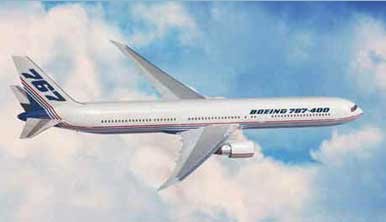Tue, May 13, 2003
They'll All Work On The Next-Generation Air Force Surveillance
System
 Northrop Grumman Corporation, The Boeing Company and Raytheon
Company officials agreed Monday to work together in developing the
U.S. Air Force's E-10A Multi-sensor Command and Control Aircraft
(MC2A). This innovative teaming agreement covers the Weapon
Systems Integration (WSI) efforts for the E-10A, which provides an
enhanced airborne ground surveillance and cruise missile defense
capability to the warfighter.
Northrop Grumman Corporation, The Boeing Company and Raytheon
Company officials agreed Monday to work together in developing the
U.S. Air Force's E-10A Multi-sensor Command and Control Aircraft
(MC2A). This innovative teaming agreement covers the Weapon
Systems Integration (WSI) efforts for the E-10A, which provides an
enhanced airborne ground surveillance and cruise missile defense
capability to the warfighter.
 "We will give the Air Force a best value program
by drawing on the legacy expertise each company brings to this
exciting new mission," said Chris Hernandez, Northrop Grumman's
vice president for Air Force Surveillance Programs. "We've
worked hard to build an agreement that will provide commanders with
the most responsive and technologically advanced ground
surveillance and battle management capability in the world at an
affordable price."
"We will give the Air Force a best value program
by drawing on the legacy expertise each company brings to this
exciting new mission," said Chris Hernandez, Northrop Grumman's
vice president for Air Force Surveillance Programs. "We've
worked hard to build an agreement that will provide commanders with
the most responsive and technologically advanced ground
surveillance and battle management capability in the world at an
affordable price."
 Increment 1 of the Air Force's evolutionary
acquisition program for the E-10A provides for an advanced airborne
ground surveillance and cruise missile defense capability. It
uses the Northrop Grumman/Raytheon Multi-Platform Radar Technology
Insertion Program (MP-RTIP) radar sensor coupled with a Battle
Management Command and Control (BMC2) system that is being competed
later this year. The teaming agreement announced Monday
covers the overall WSI contract, which is expected to be a sole
source award made later this month.
Increment 1 of the Air Force's evolutionary
acquisition program for the E-10A provides for an advanced airborne
ground surveillance and cruise missile defense capability. It
uses the Northrop Grumman/Raytheon Multi-Platform Radar Technology
Insertion Program (MP-RTIP) radar sensor coupled with a Battle
Management Command and Control (BMC2) system that is being competed
later this year. The teaming agreement announced Monday
covers the overall WSI contract, which is expected to be a sole
source award made later this month.
Under the agreement, Northrop Grumman is anticipated to be the
prime contractor and will be responsible for overall program
management and system engineering, mission system design, system
integration and flight test, and airframe modification. Primary
responsibilities for Boeing include major structural modification
design and kits, air vehicle analysis and performance assessments
and airworthiness testing.

Boeing will most likely produce the 767-400ER airframe for the
E-10A test bed under a separate contract with the government. In
addition, the Teaming Agreement anticipates that Boeing will take
the lead for any Increment 2 analysis and subsequent activities,
should the government decide to proceed with an additional
increment.
Increment 2 is not currently funded, but if implemented, is
expected to support Airborne Early Warning and Control (AEW&C)
with increased BMC2 functionality. Raytheon's primary
responsibilities include radar and radome installation, the
self-protection system, and support to system engineering, system
integration and test for the cruise missile defense
functionality.
More News
Terminal Radar Service Area Airspace surrounding designated airports wherein ATC provides radar vectoring, sequencing, and separation on a full-time basis for all IFR and participa>[...]
Very High Frequency (VHF) The frequency band between 30 and 300 MHz. Portions of this band, 108 to 118 MHz, are used for certain NAVAIDs; 118 to 136 MHz are used for civil air/grou>[...]
“From approximately November 2021 through January 2022, Britton-Harr, acting on behalf of AeroVanti, entered into lease-purchase agreements for five Piaggio-manufactured airc>[...]
Also: Virtual FLRAA Prototype, IFR-Capable Autonomous A/C, NS-32 Crew, Golden Dome Missile Defense Bombardier announced that the first production Global 8000 successfully completed>[...]
Aero Linx: The 1-26 Association (Schweizer) The Association’s goal is to foster the helpfulness, the camaraderie, and the opportunity for head-to-head competition that is fou>[...]
 ANN's Daily Aero-Term (05.29.25): Terminal Radar Service Area
ANN's Daily Aero-Term (05.29.25): Terminal Radar Service Area ANN's Daily Aero-Term (05.30.25): Very High Frequency (VHF)
ANN's Daily Aero-Term (05.30.25): Very High Frequency (VHF) Aero-News: Quote of the Day (05.30.25)
Aero-News: Quote of the Day (05.30.25) Airborne 05.23.25: Global 8000, Qatar B747 Accepted, Aviation Merit Badge
Airborne 05.23.25: Global 8000, Qatar B747 Accepted, Aviation Merit Badge ANN's Daily Aero-Linx (05.30.25)
ANN's Daily Aero-Linx (05.30.25)





